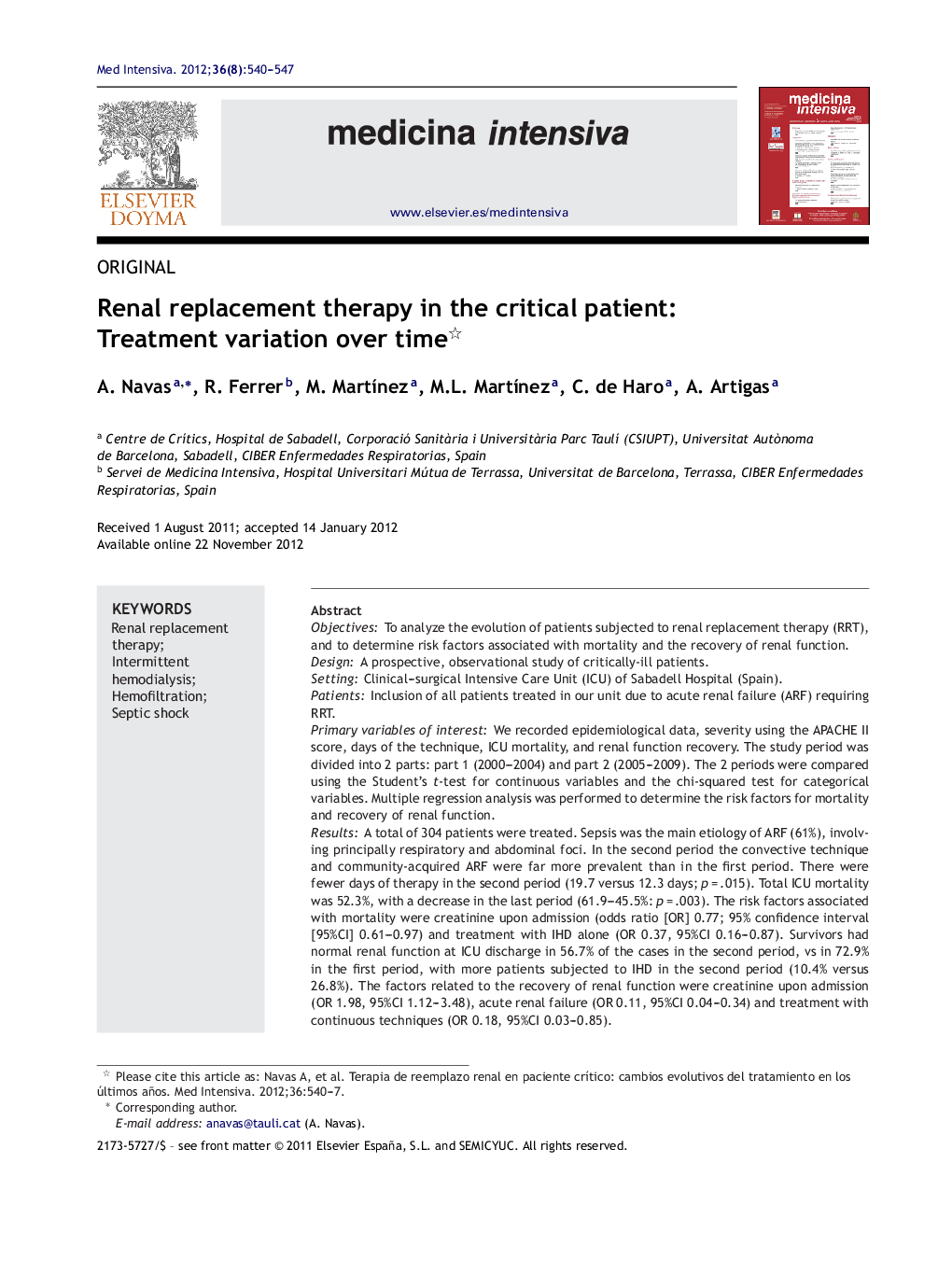| Article ID | Journal | Published Year | Pages | File Type |
|---|---|---|---|---|
| 3114225 | Medicina Intensiva (English Edition) | 2012 | 8 Pages |
ObjectivesTo analyze the evolution of patients subjected to renal replacement therapy (RRT), and to determine risk factors associated with mortality and the recovery of renal function.DesignA prospective, observational study of critically-ill patients.SettingClinical–surgical Intensive Care Unit (ICU) of Sabadell Hospital (Spain).PatientsInclusion of all patients treated in our unit due to acute renal failure (ARF) requiring RRT.Primary variables of interestWe recorded epidemiological data, severity using the APACHE II score, days of the technique, ICU mortality, and renal function recovery. The study period was divided into 2 parts: part 1 (2000–2004) and part 2 (2005–2009). The 2 periods were compared using the Student's t-test for continuous variables and the chi-squared test for categorical variables. Multiple regression analysis was performed to determine the risk factors for mortality and recovery of renal function.ResultsA total of 304 patients were treated. Sepsis was the main etiology of ARF (61%), involving principally respiratory and abdominal foci. In the second period the convective technique and community-acquired ARF were far more prevalent than in the first period. There were fewer days of therapy in the second period (19.7 versus 12.3 days; p = .015). Total ICU mortality was 52.3%, with a decrease in the last period (61.9–45.5%: p = .003). The risk factors associated with mortality were creatinine upon admission (odds ratio [OR] 0.77; 95% confidence interval [95%CI] 0.61–0.97) and treatment with IHD alone (OR 0.37, 95%CI 0.16–0.87). Survivors had normal renal function at ICU discharge in 56.7% of the cases in the second period, vs in 72.9% in the first period, with more patients subjected to IHD in the second period (10.4% versus 26.8%). The factors related to the recovery of renal function were creatinine upon admission (OR 1.98, 95%CI 1.12–3.48), acute renal failure (OR 0.11, 95%CI 0.04–0.34) and treatment with continuous techniques (OR 0.18, 95%CI 0.03–0.85).ConclusionsMortality among critically-ill patients subjected to RRT has improved in recent years.
ResumenObjetivosAnalizar la evolución de los pacientes con insuficiencia renal aguda tratados con terapia de reemplazo renal (TRR) y determinar los factores de riesgo asociados a mortalidad y recuperación de la función renal.DiseñoEstudio prospectivo y observacional en pacientes críticos.ÁmbitoUnidad de Cuidados Intensivos (UCI) polivalente del Hospital de Sabadell.PacientesInclusión de los pacientes con insuficiencia renal que precisaron TRR en nuestra unidad.Principales variables de interésRegistro de variables epidemiológicas, de gravedad (APACHE II) así como el tipo y duración de la TRR, mortalidad y recuperación de la función renal al alta de UCI. El periodo de estudio comprende 10 años, repartiendo la muestra en 2 periodos: inicial (2000-2004) y reciente (2005-2009). Análisis estadístico comparativo de ambos periodos y análisis de regresión logística múltiple para determinar factores de riesgo de mortalidad y de recuperación de función renal.ResultadosAnálisis de 304 pacientes. Principal causa de ingreso la sepsis (61%), siendo el foco respiratorio y el abdominal los más frecuentes. El origen comunitario de la insuficiencia renal y la técnica convectiva se incrementaron en el periodo reciente. Destaca un descenso de días de terapia (19,7 a 12,3; p =0,015). La mortalidad global en UCI fue de 52,3%, siendo la principal causa el fallo multiorgánico, objetivando un descenso entre ambos periodos (61,9 a 45,5%; p =0,003). Los factores relacionados con la mortalidad fueron la creatinina al ingreso (odds ratio [OR] 0,77; intervalo de confianza del 95% [IC95%] 0,61-0,97) y el tratamiento solo con HDI (OR 0,37; IC95% 0,16-0,87). De los supervivientes, al alta de UCI, en el periodo reciente destaca un aumento de los pacientes que quedan con dependencia de HD (10,4 versus 26,8%). Los factores relacionados con la recuperación de la función renal fueron la creatinina al ingreso (OR 1,98; IC95% 1,12-3,48), la insuficiencia renal aguda versus la crónica agudizada (OR 0,11; IC95% 0,04-0,34) y el tratamiento con técnicas continuas (OR 0,18; IC95% 0,03-0,85).ConclusionesLa mortalidad de los pacientes críticos tratados con TRR ha mejorado en los últimos años.
